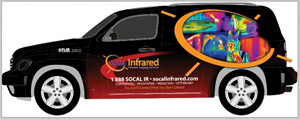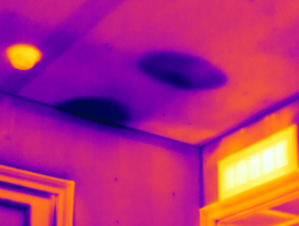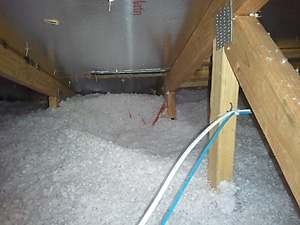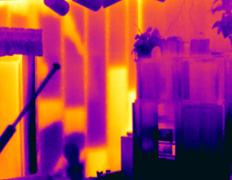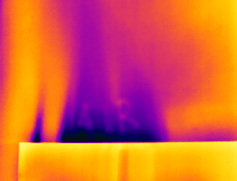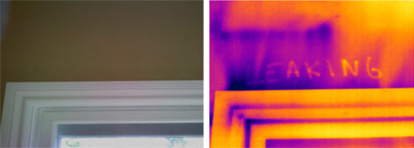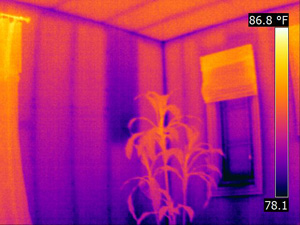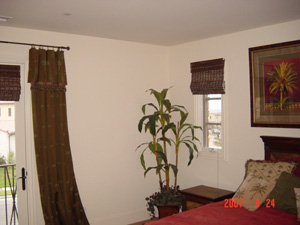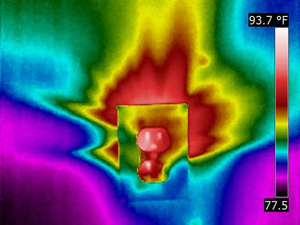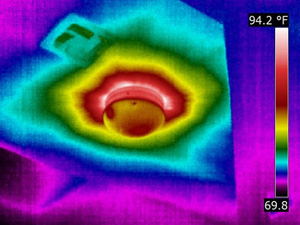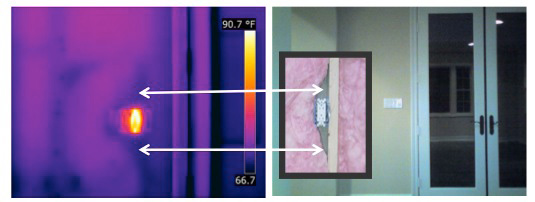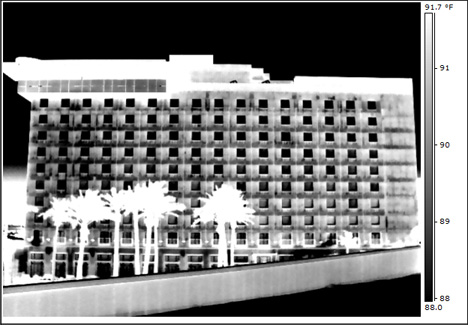Peter Hopkins, Vice President
Level III Certified Infrared Thermographer
United Infrared, Inc.
PO Box 1403Bonsall, CA 92003Ph:760-593-2339 www.unitedinfrared.com
Abstract
Change is good, sometimes we don’t always see it for what it is worth but most times it can inspire amazing results. Think about cars today and how many miles per gallon (mpg) they can get compared to when we were kids. I remember when fuel was shy of $1 a gallon and you didn’t worry about the 10 miles per gallon; however, with fuel prices now over four times that, we are putting great emphasis on how many mpg’s we can get.
The problem with saving mpg’s for most is the failure to consider the bigger picture. I look at homes this same way and believe simply changing a light bulb or even replacing your windows is not the fix. You can have the most efficient refrigerator in the world but if you leave the door open, you will not realize the benefit. Most people complain of the problem when they get their utility bill and think they are making a difference with their expensive fix to only find they have only made a cosmetic change in their life… i.e. “look at my new windows”!
Energy Audits have become more and more popular since the 1970’s. They, of course, found their peaks during an energy crisis; however, my question is: Is the energy audit fully addressing the real problem? Are people realizing the intended benefit? It is my hope with this paper to bring focus to the simple science of how heat moves in a building and how utilization of an infrared camera especially with a blower door can drastically improve how many real mpg’s your building can get.
This paper will focus on the role of thermal imaging in building energy audits.
How Green Do Your Clients Want to Be,
and How Much Do They Want to Save?
About seven years ago, I was researching a new car for my business. I narrowed the search between a hot product on the market – the Toyota Prius ($24k – 40 MPG) and the Chevrolet HHR ($15k – 26 MPG). If I bought the Prius, it would show that I was being green. I considered my options carefully and made the decision to purchase the Chevy.
I was not really all that worried about saving the planet; instead I wanted to get the best return on my investment, so I did the math: Considering the above numbers with a 5-year loan at 6% interest, the vehicles would have a monthly payment of $463 / Prius and $289 / HHR. This is an additional $174 per month for the Prius. Since I would drive it 2000 miles a month, I would use 50 gallons of gas in the Prius and about 77 gallons in the HHR, 27 gallons difference. If you calculate 27 gallons of gas at $4 a gallon, this equates to $108 more in cost for HHR. I was going to use more resources with the HHR, but financially the benefit of $66 more dollars in my bank account every month made the choice to buy the HHR.
With energy audits in buildings, there are several factors to consider for the “green” savings. Using a similar thought process as the above, you can help your clients decide whether specific energy improvements will make their building more comfortable, save them money and/or help save the planet. The question becomes go green or save green. Where one could argue that all the benefits would be nice, unfortunately, this is rarely the case. By doing competent infrared and blower door testing and presenting the results in an understandable way, you can help your clients realize more clearly what the numbers are and they will be able to decide which green they want to save, or what combination.
By Wikipedia’s definition, “Going Green” is also known as “environmentalism – a social movement that seeks to influence the political process by lobbying, activism, and education in order to protect natural resources and ecosystems”. But, the financial resources are an important factor to consider and “Going Green” may at times cost them much more.
Often, green savings can be achieved by repairing what one has now, as opposed to replacing something completely. Replacement windows are a great example of this. They may look good, but the payback could often be measured in decades. Instead of putting new windows in, why not recommend to your clients they consider air sealing the windows that they have now and install energy-efficient window coverings?
 Efficiency v. Conservation: Simply changing a light bulb or replacing your windows will not solve the real problem. You can have the most efficient refrigerator in the world, but if you leave the door open, you will not realize any benefit from its efficiency. Similarly, where it may be a good idea to have an efficient light bulb, a better choice is conservation … turning off the light.
Efficiency v. Conservation: Simply changing a light bulb or replacing your windows will not solve the real problem. You can have the most efficient refrigerator in the world, but if you leave the door open, you will not realize any benefit from its efficiency. Similarly, where it may be a good idea to have an efficient light bulb, a better choice is conservation … turning off the light.
Seeing is Believing
To address the true problem with energy usage in buildings, I recommend an infrared camera because in the hands of a competent surveyor, the images can be very compelling. Although these devices have been available since the early 60’s, most people did not even become aware of them until Arnold Schwarzenegger was seen in an alien’s thermal vision in the movie Predator. The prices of infrared (IR) cameras have come down significantly to $1000 for a starter camera. I wrote a business plan for my infrared business back in 1999 and my first quotes on cameras were in the $50- $70k range. I did not spend the money at that time, but I did six years later investing $20k. This 6-year timeframe allowed the imager cost to drop by 60%. The reduction of price is due to manufacturing economies of scale and retail distribution. In infrared, with lower prices come lower resolution imagers. A contractor cannot utilize a low resolution imager and expect to produce a report that will meet the typical client’s high expectations. Also, when someone pays only a few thousand for an imager, does it make sense for them to spend three times that to learn how to use it? I would like to forewarn those who believe the thousand dollar price point is a chance to jump in the professional thermography market. Although I had options to purchase a camera lower in price, I chose a higher resolution imager at that time and got very high quality training. I do not regret coming into the IR business when I did, in 2005, and spending twenty thousand dollars and another six thousand on training, as I saw a return on my investment within nine months of opening my company’s doors.
The most important tool on the survey of a building is the knowledge-base of the surveyor. In addition to a better camera, proper training and credentials are critical to success. I believe as the prices get lower on imagers down to consumer pricing, we will find a lot of handymen, home inspectors and contractors utilizing these devices and misleading people on the true condition of their buildings, because even though they can buy a camera, they will understand none of the science. Even today, contractors are incorporating entry level cameras to go along with zero training. Surveys conducted by these people are not helping the building owners; incompetent surveys are misleading and therefore harmful. The lower resolution and lower sensitivity of these cameras also have a negative impact on that contractor’s ability to complete a proper survey, especially when they have marginal ambient conditions. I am being asked more and more to review infrared reports from home inspectors using IR cameras. Generally, these reports reveal that the “thermographer” did the survey when conditions were not conducive to getting good results. When the schedule of the inspector or the client is considered more important than the ambient conditions, the results are going to be poor. The weather often dictates when thermography can be utilized effectively and that is not always optimal when you utilize a service that may “include” thermography. Thermography stands as a service on its own and should only be considered as such.
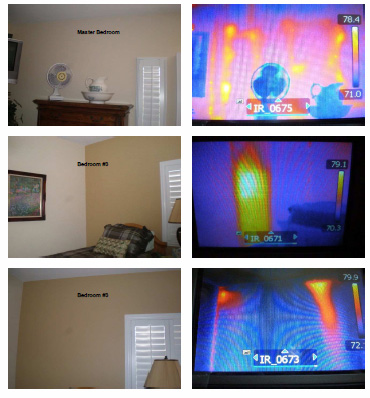 |
|
Example of a poorly conducted survey and an inadequate report taken from an unnamed report. These images represent the entire thermographic section of a report taken during a home inspection. |
|
|
|
|
Leak or missing insulation? The image on the left is a leak; however, I have seen similar anomalies with missing loose-fill insulation that occurs in attics when wind is blowing through roof vents which creates a vortex spiral in the insulation. |
Heat Moves the Green
There are three main concepts that need to be understood when trying to improve a building’s energy performance, whether it is to reduce consumption to save energy costs and/or improve comfort levels:
-
Heat seeks cool. In summer, the heat is always trying to get inside where it is cooler and in winter, the heat is always trying to get out where it is cooler.
-
Heat moves in one of three modes: Conduction, Convection or Radiation. You must consider all three modes of heat transfer when surveying a building and deciding how to reduce a building’s heat flow and air flow. Infrared cameras are excellent at seeing all three modes, but convective heat movement often will need some help and that is where the blower door enters the picture.
-
Warm air rises. The gaps in your building will allow warmer air to escape at gaps and openings like recessed light fixtures, openings around attic accesses, cracking in walls and missing weather stripping. This movement of air will create a negative pressure on your building causing holes and gaps at lower areas to allow outside air in. The rule of thumb is “Seal it tight, ventilate it right”.
By considering these principals one can then look at a building with an infrared camera (at the right time, under the right conditions) and locate where these opportunities for stopping heat loss are.
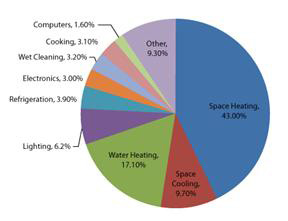 According to the United States Department of Energy, heating and cooling accounts for more than half of the energy use in a typical US home, making it the largest energy expense for most homes. For this reason, focus on the biggest consumer of energy and how we can improve that first. Unfortunately, most people are focused on the lesser users of energy in their buildings, like lights. OK, lights use energy, but are we effectively going green and saving green when focusing on something that has less than 6.2% of our annual consumption?
According to the United States Department of Energy, heating and cooling accounts for more than half of the energy use in a typical US home, making it the largest energy expense for most homes. For this reason, focus on the biggest consumer of energy and how we can improve that first. Unfortunately, most people are focused on the lesser users of energy in their buildings, like lights. OK, lights use energy, but are we effectively going green and saving green when focusing on something that has less than 6.2% of our annual consumption?
Let’s focus on the lion’s share of energy usage first and see how little we can spend on things that have the biggest impact. With the main considerations of how heat moves, evaluating the building’s envelope will allow a properly equipped and properly trained contractor to identify where heat transfer is occurring. This information can be used to make an informed decision by the building owner.
Most scientific studies are done in laboratories; however, buildings are not such a perfect environment. We often find we must create conditions to be conducive to thermography testing or rather to further enhance what we are doing naturally. We do this with heating and cooling systems prior to the survey and also with the utilization of a blower door. By incorporating a blower door into an IR survey, we are able to not only measure the amount of air movement, but also with the IR camera, we can visualize air movement.
|
|
|
|
Conductive and radiant heat transfer occurring due to missing insulation. Convective heat loss can be seen with an infrared camera and a pressure differential. |
|
|
|
Air leakage at a window found during a blower door test.
|
|
|
|
Test showing before and after blower door. Notice areas easily seen with infrared technology when a blower door is utilized. |
Infrared alone is a qualitative measurement, whereas incorporating IR with a blower door will allow you to quantify the air leakage. Some current standards like ASTM C1060 and the RESNET standard discuss proper inspection techniques along with processes for utilizing infrared in conjunction with an infrared camera. There are some guidelines on minimum resolution for conducting a survey, but a general guideline is the better the temperature differential, the better the image will show anomalies.
|
|
|
Energy Audits and Infrared Technology
Although energy audits have been around for some time, it was only in the past few years that infrared has actually become integrated into the process. This is likely due to the fact that energy audits were previously utilized for rating new construction and not for existing buildings.
With the declining economy in 2005 for most, the new construction market started to come to a halt causing energy auditors and organizations to rethink and invent “going green”. This going green movement had to focus on the existing construction.
See below, examples of existing construction and how IR thermography has helped.
|
|
|
|
Most would think an Energy Star home would be perfect, based on the marketing hype. As you can see in the examples above, what was acceptable was excessive air leakage. |
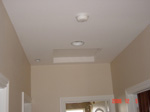 |
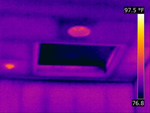 |
 |
|
One of the most common defects in a home is missing insulation at the attic access cover. Standards require that the insulation be mechanically fastened to the cover. As you can see in this imagery, it was clearly never there. |
|
|
|
One of the amazing things about IR thermography is how easy it brings to light where heat is moving. Standards require insulation to be cut around electrical boxes, with proper placement behind the box. The infrared image on the left clearly shows how the insulation is not installed correctly behind the box, creating a void allowing heat loss. The inset image on the right is an example of how this would look like when the wall is opened. |
 |
|
Homes prior to mid-1970 were not required to have insulation. A very big industry arose at that time with retrofit insulation companies offering to reinsulate houses. Since they were insulating cavities deep in the walls, the question became, how do you verify a proper job? I have the answer, but at this point I am sure you already know what it is. Notice the attic photo confirming missing insulation. |
|
|
|
|
|
Thermogram shows thermal loss occurring between floors. The photograph above shows area where wall was furred out and likely not insulated as should. Current standards require insulation on all six sides, with no gaps or voids between weather barrier and air barrier (top, bottom, left, right, front and back). |
Conclusion
There are no perfectly energy efficient buildings, which opens a business opportunity for infrared consulting and surveying contractors. Great ideas and improvements are usually the result of a change from a disruptive technology, like infrared thermography.
As the energy crisis continues, we need to focus on solutions. One thing is clear: conservation and efficiency will always be an important component. The question is, will IR and blower door testing be part of your solution?
Author Bio:
Peter Hopkins,
Level III Thermographer
Peter Hopkins has operated a successful home inspection company since 1996 (www.inspecdoc.com) and has personally performed over 7000 property inspections in addition to having performed over 1000 energy audits. The company expanded into infrared in 2005, with the opening of SoCal Infrared (www.socalinfrared.com) and has found success in many areas of diversification including Energy Audits. He is the Co- Founder of United Infrared (www.UnitedInfrared.com), a national network of contract thermographers which includes application-specific training and business coaching in a multitude of applications related to infrared technology. Peter is a Level III Certified Thermographer, ICC Code Certified Building Inspector, Electrical Inspector and Certified HERS Energy Rater. Peter lives in Southern California with his wife and two children.
Peter Hopkins
760-593-2339


